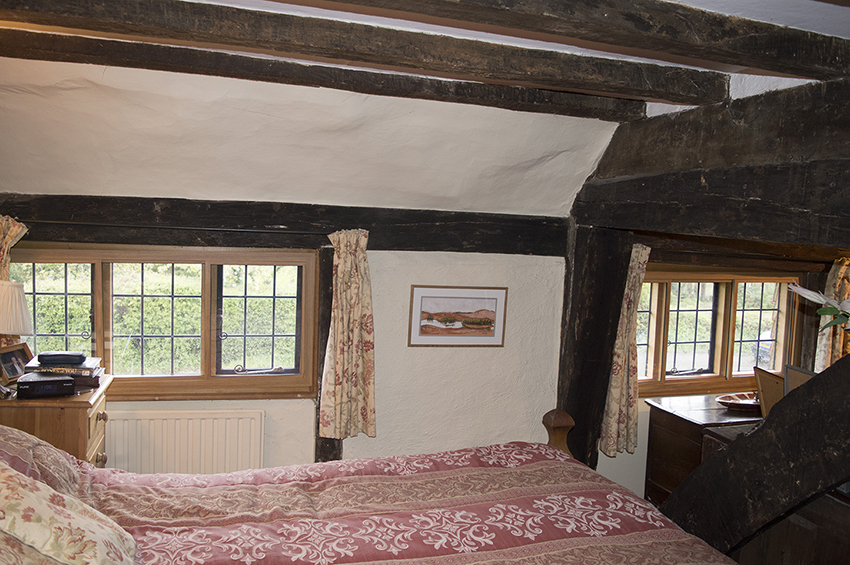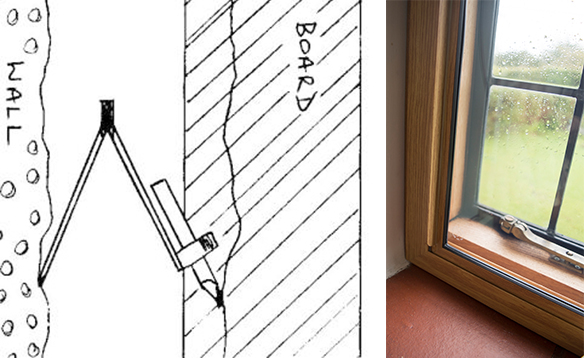Many of our older Grade I and II Listed heritage buildings are of an era when fairly primitive (but robust) building methods were used compared to today. Ranging from wattle and daub methods, to timber framed houses with single brick walls - most of these still have their original, very thin single glazed windows. Although habitable and full of charm, they are tricky to maintain, with sloping floors, walls, ceilings and off square windows. Plus, when Listed, modifications have to stay as true to the original character and architectural detailing as possible.

Grade II Listed property with sloping ceiling, timber beams and secondary glazing installed for noise insulation and thermal improvements A recent treatment, took the team to Chiddingstone – a National Trust Tudor village in Kent. They were faced with working in a beautiful, well located, 600 year old home, which had a number of charms as listed above. There were a few queries related to how secondary glazing is installed when the original window openings are so irregular? Can the aluminium be colour matched, as the property had new oak framed single glazed windows, chosen with great care to compliment the dark time worn oak timber frame and beams within the house. A concern arose regarding the need to decorate, however with secondary glazing, this isn’t needed as it is a finishing trade and leaves no mess behind after installation. After the best configuration was decided for the treatment of the windows and exacting measurements taken, Listed Building Consent was sought and granted. Secondary glazing is often the only method of enhancing the performance of primary windows, so generally accepted by Conservation Officers and heritage bodies as a reversible adaptation. The actual secondary glazed units were straightforward to manufacture, however the test came in the preparatory work of the timber grounds in the woodshop and the craftsmanship of the installers. In a project like this, key measurements are paramount to ensure the timber frames are as snug fit to the opening as possible, giving some tolerance for the installers to work with. As already mentioned, in a property of this age, nothing is straight or flat, especially the window reveals. Scribing can be seen as an art, it takes patience and a steady hand. Using various tools, a carpenter will gradually work the timber to create matching grooves and nuances to fit the surface it is being applied too.
An example of a method of scribing that some carpenters undertake, next to installed secondary glazing after the timber sub frame was scribed to form a square opening Once this had been completed, the timber ground was fixed into the reveal and then the secondary glazed units installed. Unless a close airtight finish is created, by the practice of scribing by our installers, large airgaps would be present between the grounds and original window reveal, which would undermine the performance of the units. The owners of the property were very happy with the outcome and could immediately notice the reduction in noise pollution from passing traffic and the locals exiting the pub at night. The test will come in the winter to experience the uplift in heat retention and reduction of draughts. Scribing – making a square reveal from an old timeworn irregular opening, to accept secondary glazing making the house warmer, quieter and safer for years to come.

Grade II Listed property with sloping ceiling, timber beams and secondary glazing installed for noise insulation and thermal improvements A recent treatment, took the team to Chiddingstone – a National Trust Tudor village in Kent. They were faced with working in a beautiful, well located, 600 year old home, which had a number of charms as listed above. There were a few queries related to how secondary glazing is installed when the original window openings are so irregular? Can the aluminium be colour matched, as the property had new oak framed single glazed windows, chosen with great care to compliment the dark time worn oak timber frame and beams within the house. A concern arose regarding the need to decorate, however with secondary glazing, this isn’t needed as it is a finishing trade and leaves no mess behind after installation. After the best configuration was decided for the treatment of the windows and exacting measurements taken, Listed Building Consent was sought and granted. Secondary glazing is often the only method of enhancing the performance of primary windows, so generally accepted by Conservation Officers and heritage bodies as a reversible adaptation. The actual secondary glazed units were straightforward to manufacture, however the test came in the preparatory work of the timber grounds in the woodshop and the craftsmanship of the installers. In a project like this, key measurements are paramount to ensure the timber frames are as snug fit to the opening as possible, giving some tolerance for the installers to work with. As already mentioned, in a property of this age, nothing is straight or flat, especially the window reveals. Scribing can be seen as an art, it takes patience and a steady hand. Using various tools, a carpenter will gradually work the timber to create matching grooves and nuances to fit the surface it is being applied too.

An example of a method of scribing that some carpenters undertake, next to installed secondary glazing after the timber sub frame was scribed to form a square opening Once this had been completed, the timber ground was fixed into the reveal and then the secondary glazed units installed. Unless a close airtight finish is created, by the practice of scribing by our installers, large airgaps would be present between the grounds and original window reveal, which would undermine the performance of the units. The owners of the property were very happy with the outcome and could immediately notice the reduction in noise pollution from passing traffic and the locals exiting the pub at night. The test will come in the winter to experience the uplift in heat retention and reduction of draughts. Scribing – making a square reveal from an old timeworn irregular opening, to accept secondary glazing making the house warmer, quieter and safer for years to come.
- Date
- Category
- Treat Of The Month